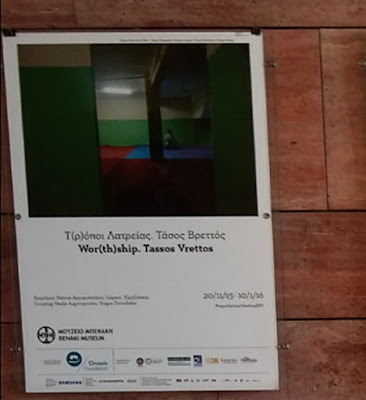Good News! Besides welcoming in the New Year of 2016, we can welcome as well the re-opening on the 4th of the Institute after its Holiday Recess. Our normal open hours (Monday – Friday, 09:00 – 13:00) are in effect. Jonathan is catching up on Institute business, Sarah is resuming the updating of the Portal to the Past and I am working on the final version of the Program for our 40th Anniversary Colloquium here in Athens on June 10th and 11th. We await the arrival of Esther Knegt this coming weekend. She is the winter/spring undergraduate intern from the University of Waterloo.
“This is War”
It is not often that a play by a Canadian playwright is performed in Athens. Just before Christmas the play “This is War” by Canada’s well-known and frequently-awarded Hannah Moskovitz’s opened at the Theatro Porta at Mesogeion 59. The play focuses on an “incident” and its aftermath that occurred during the Canadian “Training Forces” presence in Afghanistan in the early 2000s. This work was inspired by Moskovitz’s research for the radio drama series she wrote, “Afghanada” (www.cbc.ca/afghanada) which ran on the CBC from 2006 – 2011.
This is a riveting work with four Canadian soldiers (one of whom is a woman) and an extremely minimalist staging. The translation by Tomas Moschopoulos, the staging by the original Canadian director Alan Dilworth and the acting by the Greek actors makes one feel that this is truly Canadian, despite monologues and dialogues in Greek. While the playwright claims that this is not an anti-war play it nevertheless raises many core issues for the audience to ponder relating to combat: what is the difference between training foreign soldiers to fight and advising as well as supporting them while they fight? Who is the enemy in the civilian population and how can you tell that they going to harm you? How does a female soldier fit into an essentially all-male military in combat? How can soldiers express their personal feelings and needs in a war zone? What is the cost to those who survive the warzone experiences?
If you are living in Athens or are visiting, you still have a chance this month to see this thought provoking work (http://www.porta-theatre.gr/index.php/el/theatro-plays/130-this-is-war) supported by the Canadian Embassy . It is worth the effort to venture out of the central core of the city and the comfort zone of the Anglophone environment.
The Other Religious Communities of Contemporary Athens
I recommend another journey beyond the confines of “Classical Athens”
– to the Benaki Museum Annex on Piraeus Street 138 on the southern edge
of the Gazi District. Among the current four temporary exhibitions is
photographer Tassos Vrettos’ “Wor(th)ship” (in Greek: T(r)opoi Latreias).
“The photographic ‘fieldwork’ of Vrettos among the makeshift places of worship of migrants and refugees in and around Athens records an invisible network within the city: basements and rented flats, apartment blocks and garages, playing fields and outdoor public spaces, squares and courtyards, structures made ad hoc in temporary or permanent addresses for groups of Buddhists, Muslims, Hindus, Spiritualists and Christians of various denominations and multiple ethnic origins (Ethiopian, Afghan, Egyptian, Pakistani, Nigerian, Senegalese, etc.). It is a ‘work in progress’ that began in 2012 with the collaboration of these communities’ members themselves and with the utmost respect for their identities."
The amazing number (44) and the diversity of these religious communities in Athens, its suburbs and Attika reflects the growing impact of immigration (whatever form it takes) in the past two decades on the city’s contemporary culture. Unlike the fast food and restaurants which serve the cuisine of these ethnic communities, their places of worship are mostly invisible to those to who don’t look. So before the end of the month take a walk on the wild side and visit the exhibition to learn more about our city and its “Other”.“Fotis Kontoglou from Kydones: By his hand and imagination” - a Retrospective Exhibition
Much closer to home on Vas. Sofias Avenue is a recently-opened retrospective exhibition at the Byzantine and Christian Museum featuring the life and work of the multi-talented Fotis Kontoglou. A refugee from Kydonies in Asia Minor he was an influential member of the seminal interwar “Generation of the Thirties” of artists, writers, architects, critics and scholars who laid the foundations of contemporary Greek culture.
“In 2015, the Byzantine and Christian Museum is honouring Fotis Kontoglou (1895-1965) on the 50th anniversary of his death. The Museum dedicates to the artist a major retrospective exhibition that presents Kontoglou’s multifaceted contributions to 20th-century Greek culture as an artist, a painter of religious and secular works, a writer, a critic, a colour researcher, a conservator.
The retrospective was decided upon because of the artist's personal and artistic ties to the Museum: he collaborated and worked here as a painter, copyist and conservator during the twenties and thirties; many works by him, and now also his personal archive are kept in the Museum; most importantly, Kontoglou researched deeply and served Byzantine and Post-Byzantine Art. Besides, his peculiar artistic idiom of his is clearly inspired by his view that the Byzantine and Post-Byzantine Art are part of an uninterrupted painterly tradition of Hellenism. Kontoglou is the artist who dared and succeeded in reviving a defunct artistic idiom, imposing it as a living and vivid painterly language.The exhibition proceeds mainly chronologically, divided into five sections: four of them cover his lifetime (1893-1965) while the fifth presents his longtime relationship with the Byzantine and Christian Museum from the twenties onwards.”
The exhibition will expand your horizons on the nature of Byzantine art, especially frescoes, as well as on the documentation and the preservation of Athens’ Byzantine and Post-Byzantine monuments. You have until May 8th to see this large display of his work and its historical context. The llissa Café at the Museum is an excellent place to contemplate what you have seen! (http://www.byzantinemuseum.gr/en/temporary_exhibitions/?nid=2038).
There is so much to do in Athens on the winter weekends!
Cordially,
David Rupp
Director








No comments:
Post a Comment